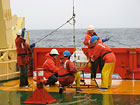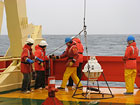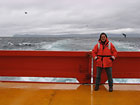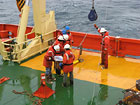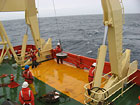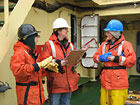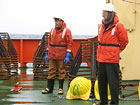

 | ||||||||||||||||||||||||||||||||||||||||||
|
|
Journals 2007/2008Mark Goldner
November 15, 2007 55° 23' S, 64° 28' W Today the science began. All the preparations, travel, packing, tying down have come down to the real purpose of this cruise. We began deploying several of the instruments in the ocean that will be used to collect a variety of data. Fortunately the seas continue to be calm, which made the deployments relatively straightforward. We had some gentle swells all day - no higher than 5-6 feet. This boat is remarkably stable in those seas. An easy rolling is all we feel, which is nice for falling asleep! The weather forecast is for continued calm; I'm happy about that, but I'm sure it's bound to change before too long.
We traveled around the tip of South America, through a narrow strait called "Strait de la Mer." We are now traveling due south, dropping a couple of "Current Moorings" and a series of "CPIES" (more on those in coming days!)
As we stood on the deck of the ship, working hard to get heavy equipment overboard, I was thinking of what interesting lives these scientists lead. Remove from your mind any stereotype of the nerdy scientist in a white lab coat spending his days in a sterile laboratory! These are scientists who spend many months of the year on board a ship, collecting data by moving heavy equipment in rough seas. They enjoy being outside, being on the ocean, and doing physically tiring work while they discover new things about the world around them.
Much about the people I have joined for this cruise impresses me. First of all, they are very bright and creative. The science of oceanography isn't an easy one to understand, and they are at the top of their field. Their creativity shines through in the experiments they design, the type of instruments they've developed to make the measurements they want, and also how they problem-solve well around any unintended difficulties they encounter. Secondly, they all share a spirit of adventure. They've all traveled extensively around the world to do their research. It's been fun to listen to them swapping stories of this and that cruise and their experiences in different parts of the ocean and different countries. Finally, there is a strong sense of cooperation and teamwork among them. This cruise is such an enormous effort, that there's no way it can be done without a large team of people working together.
Let me introduce this incredible team of scientists: the person who extended an invitation for me to join this team is Dr. Kathleen Donohue, a professor of oceanography from URI. The rest of the URI team includes: oceanography professor Dr. Randy Watts, researcher Karen Tracey, and engineers Erran Sousa and Gerry Chaplain. The URI team is collaborating with a team from Scripps Institute in San Diego, consisting of Dr. Terri Chereskin, who is the chief scientist on board, researcher Sharon Escher and graduate student Yvonne Firing. We are also joined by Ariel Troisi, an oceanographer from Argentina.
In addition to the scientists, there are several support personnel on board the ship who assist the scientists. These are mostly young people who have found a wonderful lifestyle that combines their love for travel and adventure with an interest in science. Many of them have spent lots of time in Antarctica, and all of them have spent a lot of time at sea.
There's also the crew who run the ship, keep the engines working, and cook our meals. I'll introduce them soon, in a later post. By the way, a vessel like this is far from a men-only world. Half the scientists are women, as are most of the support crew, the second mate and one of the cooks.
|
|||||||||||||||||||||||||||||||||||||||||
